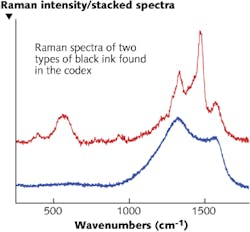A group at the Istituto Centrale per il Restauro e la Conservazione del Patrimonio Archivistico e Librario (Rome, Italy) has done a spectroscopic analysis of the pigments and other materials used in the Purple Codex Rossanensis, a sixth-century illuminated manuscript of the Bible’s New Testament (an “illuminated” manuscript includes decorative designs along with the text). The group examined the original material as well as materials used in a restoration attempt done early in the 20th century by a miniaturist painter. One of the discoveries was the first experimental evidence of the use of a pigment called “elderberry lake” in the manuscript. Both optical and x-ray spectroscopy were used in the investigation.
In the optical portion of the analysis, fiber-optic reflectance spectra (FORS) were collected using an MCS 600 spectrometer from Zeiss (Oberkochen, Germany), with special attention paid to the purple dye used throughout the manuscript. Results showed that, rather than the expected dye (Tyrian purple), the purple substance was orchil (a dye extracted from lichen) mixed with sodium carbonate. Micro-Raman and micro-Fourier-transform infrared (μFTIR) spectrometers collected additional data. For the x-ray spectroscopy, a portable spectrometer made by Assing (also of Rome) producing a 2-mm-diameter collimated x-ray beam took measurements lasting up to an hour each. Along with the spectra collected from the substrate and pigment materials, the analysis showed the presence of lead, which probably came from the tools used to mix the dyes. Contact Marina Bicchieri at [email protected].
